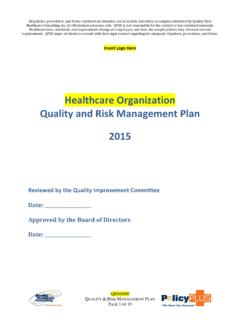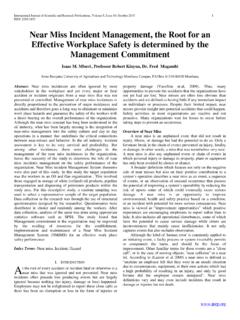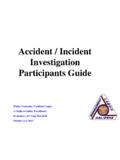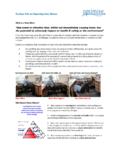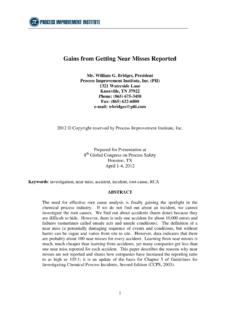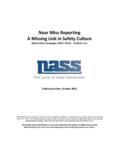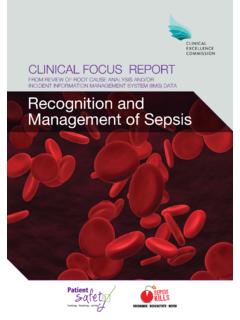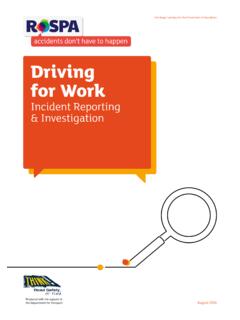Transcription of SAMPLE QM-Incident Management Policy
1 All policies, procedures, and forms reprinted are intended not as models, but rather as samples submitted by Quality First Healthcare Consulting, Inc. for illustration purposes only. QFHC is not responsible for the content of any reprinted materials. Healthcare laws, standards, and requirements change at a rapid pace, and thus, the SAMPLE policies may not meet current requirements. QFHC urges all clients to consult with their legal counsel regarding the adequacy of policies, procedures, and forms. Insert Logo Here DEPT/OPS AREA: Policy NAME: Policy NUMBER: QUALITY / RISK Management . incident Management QRM0000. EFFECTIVE (ORIGINAL) DATE: REVISED DATE: APPROVAL DATE: DATE REVIEWED: APPROVED BY: BOARD OF DIRECTORS. APPLIES TO: Policy STATEMENT: incident Management supports risk containment and risk control components of HEALTH CENTER's risk Management program.
2 The purpose of incident Management is to identify potential and actual risks and, thus, eliminate hazards. Meaningful accountability requires the organization to use the reports to improve patient safety therefore, incident Management findings are incorporated into HEALTH CENTER's quality and risk Management programs to facilitate detection of unusual events, emerging problems, or trends. KEY DEFINITIONS: incident : Defined as an occurrence that is inconsistent with routine facility operation or patient care. Examples of incidents include but are not limited to: Drug reactions/events Medication Errors Injury or loss of function requiring treatment or lifestyle change. Serious physical and psychological injury, or risk thereof (Sentinel Event- Joint Commission). Unexpected death or risk thereof (Sentinel Event-Joint Commission). RESPONSIBILITY: The Board of Director's (BOD) and the Chief Executive Officer (CEO) have ultimate responsibility for the incident Management Policy .
3 The BOD delegates oversight of this Policy to the Quality Improvement Committee (QIC) to conduct incident reviews, rending analysis and make recommendations for performance improvements, when improvement opportunities are identified. The CEO delegates the responsibility to effectively oversee the incident Management process to the Medical Director who delegates the operational activities to the Director of Quality or designee. IMPLEMENTATION: HEALTH CENTER's incident Management process: QRM0000. incident Management . PAGE 1 OF 4. DEPT / OPS AREA: Policy NAME: Policy NUMBER: QUALITY / RISK Management incident Management QM0000. HEALTHCARE ORGANIZATION. describes incidents that are unexpected, unusual, or out of the ordinary routine of HEALTH. CENTER's operations, whether or not they cause injury;. provides the basis for a timely and comprehensive investigation of an incident , if necessary.
4 Provides information with which corrective or remedial action may be planned;. provides raw data to identify risk trends for recurring issues and patient safety risks and to institute procedural changes or in-service training; and provides the information necessary to defend staff members or the HEALTH CENTER facility itself. Describing the incident : An incident report should be completed in a timely manner by the person who first witnessed or discovered the incident or by the person most closely involved in the incident . Documentation should consist only of facts stated in a clear, concise, objective, and comprehensive manner. Each reported incident is documented using the incident Management Worksheet and submitted to the Director of Quality or designee for process Management . Investigating the incident : incident investigations must be completed within 14 business days.
5 Information gathered during the investigation process may include statements from involved parties, medical record review, and/or review of possible previous and similar incidents. The Director of Quality or designee gathers sufficient documentation related to the incident , completes a summary description of the incident and sends the file to the Medical Director for continued processing. After a thorough investigation and review of documentation each incident is classified as either a Near Miss or Adverse incident /Event . Near Miss: Defined as an event or situation that could have resulted in an accident, injury, or illness but did not, either by chance or through timely intervention. Near misses are opportunities for learning and afford the chance to develop preventive strategies and actions. Near misses receive the same level of investigation as adverse incidents that result in actual injury.
6 Adverse incident /Event: Defined as an undesired outcome or occurrence not expected within the normal course of care or treatment, disease process, condition of the patient, or delivery of service. Identifying something as an adverse incident does not imply "error," "negligence," or poor quality care. It simply indicates that an undesirable clinical outcome resulted from some aspect of diagnosis or therapy, not an underlying disease process. Root Cause Analysis: To improve the quality of care and clinical safety HEALTH CENTER completes a root cause analysis for all incidents classified as near miss and adverse . The root cause analysis: 1. Focuses on primarily on systems and processes, not on individual performance. 2. Progresses from special causes in clinical processes to common causes in organization processes 3. Digs deeper into reasons why the near miss or adverse incident occurred to determine root causes.
7 4. Identifies changes that could be made in systems and processes that would reduce the risk of such events occurring in the future. QRM0000. incident Management . PAGE 2 OF 4. DEPT / OPS AREA: Policy NAME: Policy NUMBER: QUALITY / RISK Management incident Management QM0000. HEALTHCARE ORGANIZATION. 5. Identifies the factors that underlie variation in performance, determines the underlying system problems and/or failures. Actions: Systems- Focused: Actions are systems and prevention focused. Prevention strategies can include identifying points in the system of care where protocols should be changed, new or different technologies implemented, training revised, or other processes changed. Each root cause analysis is presented to the QIC for discussion and assistance in recommending actions Individual-Focused: Although the intent of HEALTH CENTER's incident Management process is to focus on systems-focused prevention strategies HEALTH CENTER at times and depending on the seriousness of the incident or trends may impose corrective actions on providers.
8 All concerns must be substantiated by the peer review process prior to the imposition of any corrective actions. Corrective actions are based on the severity of the current and any past documented incidents. Actions should be based on the following severity scale: Level 1: incident with no adverse effect on the patient. Level 2: incident with minimal adverse effect on the patient. Level 3: incident with significant adverse effect on the patient. Corrective actions and follow-up activities may be assigned to appropriate individuals/departments by the Medical Director or other designated peer reviewer. Upon completion of the corrective actions the provider will be informed of outcomes. Reviews resulting in reduction, suspension, or termination of a provider's status will be reported to the National Practitioner Data Bank and/or any other applicable state or federal agencies.
9 The provider has the right to appeal any corrective action determination made by HEALTH CENTER. Please refer to any related desk procedures for additional information. DOCUMENTATION/MONITORING: All incidents are documented on the incident Management Worksheet. Completed worksheets are kept secured and locked. All peer review records associated with peer reviewed incident investigations are confidential and peer review protected. Completed investigations including any peer review corrective action documentation are maintained by the Medical Director or Chief Executive Officer in a secure and locked area and incorporated into the reappointment processes, as appropriate. Blinded incident Management trending reports are reviewed by the QIC at least quarterly. Information from these reports is used to track trends, provide feedback, and educate, all of which allow for system improvements.
10 In addition, the information protects HEALTH CENTER by minimizing future risk and reducing the institution's legal vulnerability. REFERENCES: Joint Commission Comprehensive Accreditation Manual for Ambulatory Care. , Sentinel Events; 04. QRM0000. incident Management . PAGE 3 OF 4. DEPT / OPS AREA: Policy NAME: Policy NUMBER: QUALITY / RISK Management incident Management QM0000. HEALTHCARE ORGANIZATION. Program Assistance Letter 2010-06, New Requirements for Deeming under the Federally Supported Health Centers Assistance Act for Calendar Year 2010. RELATED POLICIES AND/OR PROCEDURES: Insert as relevant KEYWORDS: incident , Near miss, Adverse event, Root cause, Joint commission, QRM0000. incident Management . PAGE 4 OF 4.
